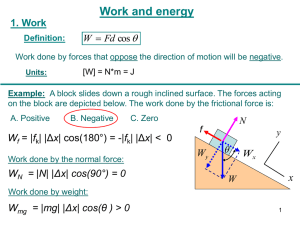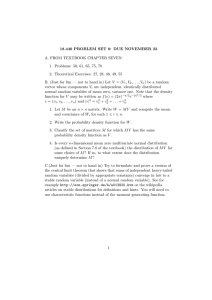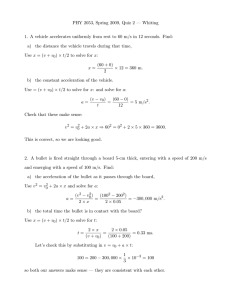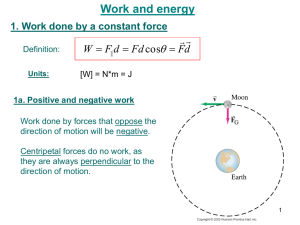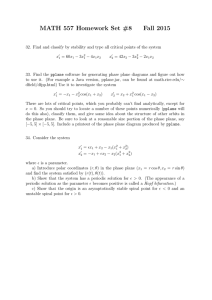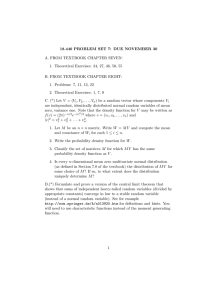Solutions Assignment 5 5.11 From the conservation of energy we have 1
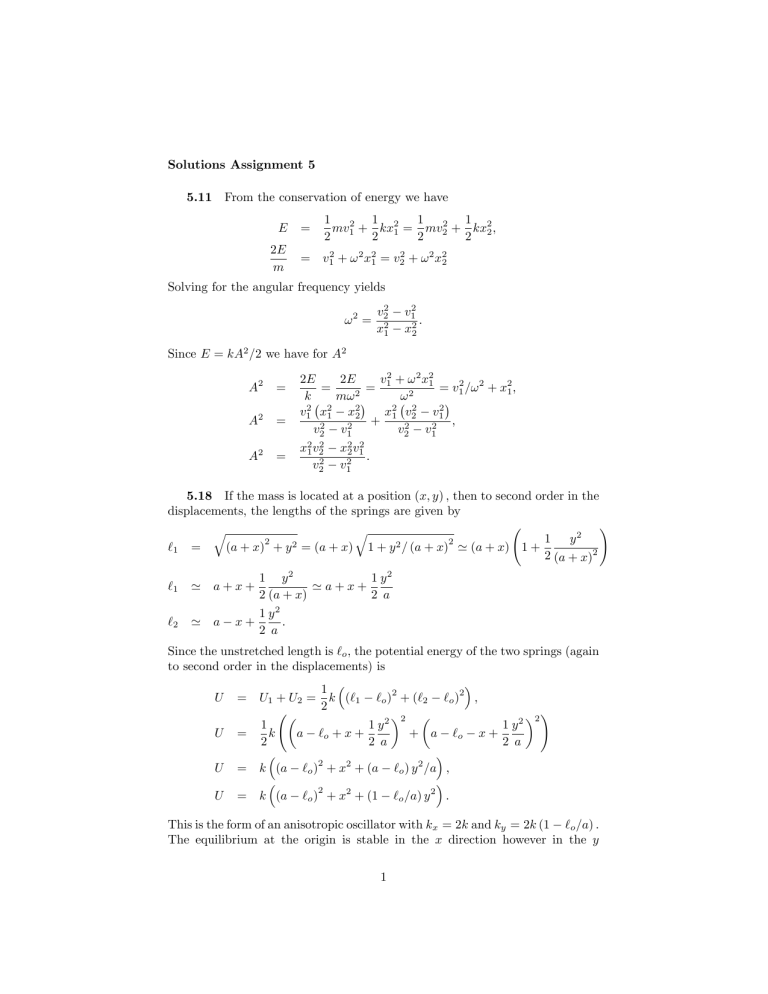
Solutions Assignment 5
5.11
From the conservation of energy we have
2 E m
E =
1
2 mv
2
1
+
1
2 kx
2
1
=
1
2 mv
2
2
+
1
2 kx
2
2
;
= v
2
1
+ !
2 x
2
1
= v
2
2
+ !
2 x
2
2
Solving for the angular frequency yields
Since E = kA
2
= 2 we have for A
2
!
2
= v 2
2 x 2
1
A
A
A
2
2
2
=
=
= v x
2
1
2
2
:
2 E
= k v
2
1 x
2
1 v 2
2 x 2
1 v 2
2 v 2
2
2 E m!
2 x
2
2 v 2
1 x 2
2 v 2
1 v 2
1
:
=
+ v 2
1 x
2
1
+ !
2 x 2
1
!
2 v
2
2 v 2
2
= v 2
1 v
2
1
; v
2
1
=!
2
+ x
2
1
;
5.18
If the mass is located at a position ( x; y ) ; then to second order in the displacements, the lengths of the springs are given by
`
1
= q
( a + x )
2
+ y 2 = ( a + x ) q
1 + y 2 = ( a + x )
2
' ( a + x ) 1 +
1
2 ( a y
+
2 x )
2
!
`
`
1
2
' a + x +
1
2 y 2
( a + x )
' a x +
1
2 y
2
: a
1 y 2
' a + x +
2 a
Since the unstretched length is ` o
; the potential energy of the two springs (again to second order in the displacements) is
U
U
=
=
U
1
1
2 k
+ U
2 a
=
`
1
2 o k ( `
1
+ x +
1
2
` o y 2 a
)
2
+ ( `
2
2
+ a
` o
)
`
2 o
;
1 y 2 x +
2 a
2
!
U = k ( a ` o
)
2
+ x
2
+ ( a ` o
) y
2
=a ;
U = k ( a ` o
)
2
+ x
2
+ (1 ` o
=a ) y
2
:
This is the form of an anisotropic oscillator with k x
= 2 k and k y
= 2 k (1 ` o
=a )
The equilibrium at the origin is stable in the x direction however in the y
:
1
direction the spring constant is greater than zero only when a > ` o
: The physics here is clear, if the springs are under compression, a < ` o
; then when the mass moves away from the origin in the vertical direction the compression in the springs continue to push the mass even further away from the origin.
5.23
The EOM for a damped oscillator is m d 2 x dt 2
+ b dx dt
+ kx = 0 !
m d 2 x dt 2
+ kx = b dx
; dt where the damping force is F dmp by
E = m
2
= bdx=dt: The mechanical energy is given dx dt
2
+ k x
2
:
2
The rate of change of this energy is dE dt
= m d 2 x dt 2
+ kx dx dt
= b dx dt dx dt
= F dmp dx
; dt which is the power dissipated by the damping force ( bdx=t < 0 ), i.e. the rate of energy dissipation.
5.27
(a) A critically damped oscillator satis…es x ( t ) = C
1 e t
+ C
2 te t
:
Solving for the times when x ( t ) = 0 ; we …nd
( C
1
+ C
2 t ) e t
= 0 !
( C
1
+ C
2 t ) = 0 !
t = C
1
=C
2
:
This is the only solution other than e t
(b) An overdamped oscillator satis…es
= 0 whose solution is t = 1 : p
2 x ( t ) = C
1 e
!
2 o t
+ C
2 e
+ p
2
!
2 o t
:
Solving for the times when x ( t ) = 0 ; we …nd e
C
1
+
2 p
2
C
2 e
!
2 o t
2 p
=
2
C
!
2 o t
1
=C
2 e
; t =
2 q
C
2
2
=C
1
)
!
2 o
: p
2 !
2 o t
= 0 ;
Again only one solution other than that at t = 1 :
2
5.44
(a) The expression for the position of a driven weakly damped oscillator being driven at !
= !
o is x ( t ) = A cos ( !
o t ) + A tr e t cos ( !
1 t tr
) :
After the transients have died out we have x ( t ) = A cos ( !
o t ) and x ( t ) =
!
o
A sin ( !
o t ) : Hence the energy stored in the spring is
E
E
=
=
2
1
1 mx
2
2 m!
2 o
( t ) +
A 2
1
2 sin
2 kx
2
( !
o
=
1
2 mx
2
( t ) + t ) + cos 2
1
2 m!
2 o x
2
;
( !
o t ) =
(b) From problem 5.23 we know that
1
2 m!
2 o
A 2 : dE dt
= m d 2 x dt 2
+ kx dx dt
= b dx dt dx dt
= F dmp dx
; dt so that
F dmp dx dt
= b dx dt
2
= b!
2 o
A
2 sin
2
( !
o t ) = 2 m!
2 o
A
2 sin
2
( !
o t ) :
Now the average power dissipated per cycle is 1/2 of this and h P i = m!
2 o
A
2
:
Integrating this over one cycle yields
E dis
= m!
2 o
A
2
2
!
o
= 2 m!
o
A
2
:
(c) Now the expression
2 E= E dis
= m!
2 o
A
2
= 2 m!
o
A
2
= !
o
= 2 ; which is the de…nition for Q .
6.9
Consider the integral
Z
P
I = y
0 2
O
+ yy
0
+ y
2 dx =
Z
O
P f ( y; y
0
) dx:
For this integral to be stationary then y must satisfy the Euler Lagrange equation, d @f dx @y 0
2 y
00
@f
@y
= 0 !
d dx
2 y = 0 !
y
00
(2 y
0 y
+
= 0 y ) y
0 y = A sinh x + B cosh x:
2 y = 0
The curve must pass through (0 ; 0) and (1 ; 1) : Passing through the origin requires B = 0 while passing through (1 ; 1) requires
1 = A sinh 1 !
A = 1 = sinh 1 y = sinh x= sinh 1 :
3
6.11
The path for the integral for which
I =
Z
1
2 p x p
1 + y 0 2 dx =
Z
1
2 f ( y
0
; x ) dx is stationary is found from the Euler Lagrange equation d @f @f dx @y 0 @y p x p y 0
1 + y 0 2 x a
2 y
0 2
= d @f dx @y 0
@f
= 0 !
@y 0
= a
= a !
xy
0 2
= a
2
1 + y
0 2 y y y
0
2 a y
0
2
= a
2
= a
Z
!
p dy dx dx
= x a 2 a p x a 2
= 2 a p x a 2
= x a
2
This is a parabola that is symmetric about y = y
0
:
6.15
Measuring y positive in the downward direction, the velocity of the bead as it descends is v = v 2
0
+ 2 gy: Hence the time to descend from point 1 to point 2 is
T =
Z
1
2 p dx 2 v
+ dy 2
=
Z
1
2 p dx 2 p v 2
0
+ dy
+ 2 gy
2
:
To simplify the Euler Lagrange equation it is convenient to write this as
T =
Z
1
2 p
1 + x 0 2 p v 2
0
+ 2 gy dy = p
1
2 g
Z
1
2 p p v
1 +
2
0
= 2 g x 0 2
+ y dy:
The Euler Lagrange equation is d dy
@f
@x 0
@f
@x
= d @f dy @x 0
= 0 :
Hence
@f
@x 0
= p v 2
0 x
0
= 2 g + y p
1 + x 0 2 where a is a constant. Solving for x 0 ;
= p
1
2 a
;
2
Z ax
0 2 dx
= v
2
0
Z
=
= 2 g + y 1 + x
0 2 p p v 2
0
=
2 a v
2
2
0 g
=
+
2 g y y
!
2 a v dy =
Z
2
0
= 2 g p u p
2 a u y x du;
0 2
= v
2
0
= 2 g + y
4
where we have de…ned u = y + v a (1 cos ) = 2 a sin
2
= 2 ; and du
2
0
= 2
= (2 g: a
Again make the substitution sin = 2 cos = 2) d : u =
The integral then becomes x x
=
=
Z p
2 a sin = 2 p
2 a cos 2 = 2
Z a
(2 a sin = 2 cos = 2) d = 2 a
Z sin
2
= 2 d
(1 cos ) d = a ( sin ) ; and y = a (1 cos ) v
2
0
= 2 g:
This is the same curve that we obtained for the Brachistochrone except that it is shifted up by the height v 2
0
= 2 g (remember y is positive in the downward direction).
Green’s Function Given the Green’s function,
G ( t t
0
) = ( t t
0
) e
( t t
0 ) ( t t
0
) ;
…nd the particular solution when the forcing function is g; a constant.
From our discussion in class we have
Z
1
Z x p
= G ( t t
0
) gdt
0
= g
Z
1 t x p
= g ( t t
0
) e
1
( t t
0 ) dt
0
;
1
1
( t t
0
) e
( t t
0 ) ( t t
0
) dt
0
; where this last step was due to the step function vanishing when t 0 changing variables to = t t 0 we have
> t: Now x p
= g
Z
0
1 e d = g
Z
0
1 e d = g=
2
; which is the solution we obtained via observation in class.
5
